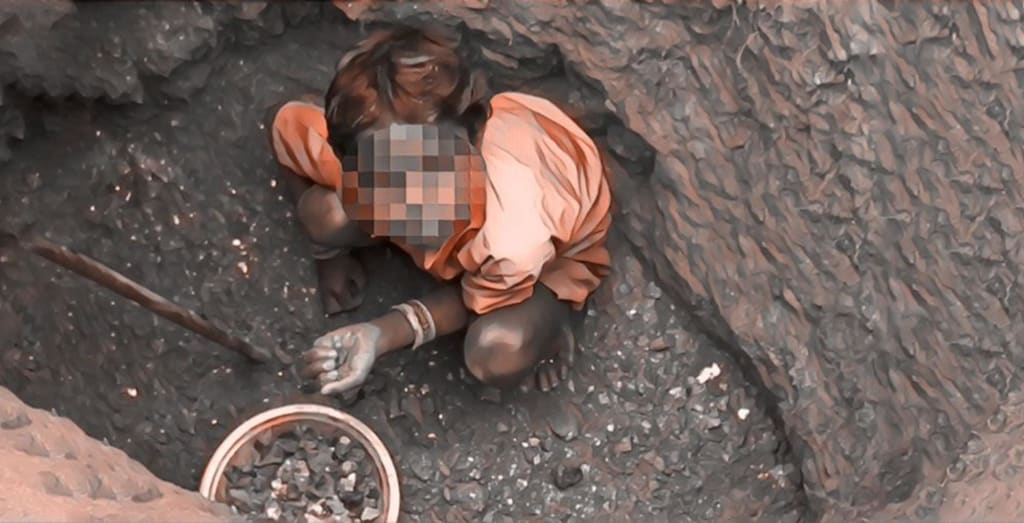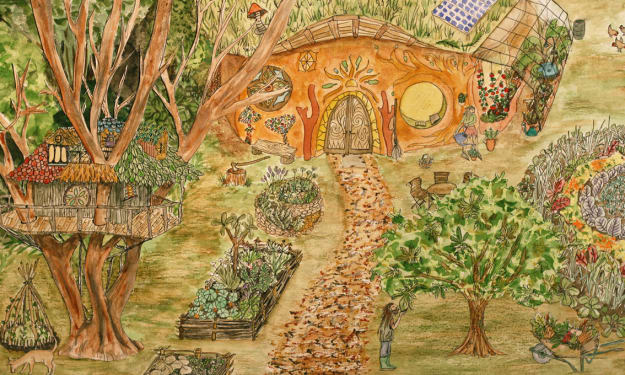Mica Mining and Child Labour
Is the sparkle worth your sparkle?

The use of child labor for the illegal mining of precious metal and minerals like mica and columbium is one of the worst forms of exploitation of children. It occurs in many countries including the Democratic Republic of Congo, Zambia, Lesotho, Namibia, Zimbabwe, Burundi, Cambodia, India, and the Philippines. Since the mining of mica and other precious minerals often results in death or severe injuries to children, it has been subject to international attention in recent times.
The U.S. State Department's Bureau of International Narcotics and Law Enforcement (INCLE) stated in its 2020 report that most of the cases they had investigated were instances where children were hired by local miners sponsored by big companies to do unprofitable jobs. In many cases, children became trapped within a mine shaft and died due to lack of oxygen. In more severe cases, the children end up battling health issues that were birthed by the constant close contact with harmful mine chemicals for the rest of their lives. The purpose of this write-up is to bring to light the prevailing issue of the exploitation of children for mica mining and steps being taken to eradicate it.
Mica Mining
A cursory look at the history of mica shows that the very first humans to live upon the earth used this valuable stone as tools and building material.
Mica is found naturally in a variety of places including dunes, swamps, volcanic rock, desert, and grasslands. The mica mining method goes through a three-step process to obtain the raw material. The first step involves extracting the mica from the earth. Next, the minerals are separated from the mica and washed away to prevent contamination. Lastly, the clean mica minerals are further processed to form the finished product. The processed mica is used in building materials or in making cosmetics, pharmaceuticals, electronics, paints.
The Impact of Mica Mining
This process of mica mining is not only hazardous to the children involved but also to the society and world at large. It causes several problems ranging from physical to social. It results in the dislocation of the communities where the mining takes place, affecting the lives of the local people. Environmentalists also claim that mining affects the environment in many ways. It alters the natural environment through the burning of wastes and acid rain. Moreover, mining dredges up and discharges heavy metals into the environment, polluting the water and the soil. Besides these, mica mining also involves a lot of health risks. Mica contains lead, which is a toxic metal that can cause various diseases such as lead poisoning, cancer, etc.
Mica Mining and Child Labour
Mining mica is a form of slavery. It is estimated that there are about 200,000 children who are forced to work mining in mica fields in several countries all over the world. The main problem with this kind of child labor is that they are forced to work in dangerous conditions and are subjected to hazardous working conditions. The children that are trapped in this type of situation cannot go to school or seek a job that will provide them with a decent living. They are also forced to work long hours with little food or money.
Illegal mining of mica and child labor occurs when young kids are hired directly by companies or indirectly by adult miners to do the dirty work of extracting minerals from the ground. The payment these young workers receive is not enough to live on and they are usually forced to live in degrading conditions. Some of these miners die of asphyxiation due to exposure to high levels of radiation and other harmful substances during the extraction process. Some are even working in unhealthy working environments with little or no protection from the harmful effects of the working surroundings.
The Eradication of Child Labour in Mica Mines
Activists from diverse countries have been working hard to stop this type of exploitation. By using education and organizing protests, they are attempting to put the spotlight on mining operations and the use of child labor, which they say is widespread. In the past, mica mining by companies that utilize mica as part of their raw materials did not cause much of a problem because the local population was able to support themselves through other means. However, there have been reports that the practice of child labor in mining areas has been on the rise over the past few years due to the financial instability of those local communities.
The problem of using child labor for mica mining is not only caused by the financial instability of those local communities but also due to the lack of awareness about the harmful effects of mining, labor laws, workers’ rights, the benefit of education, etc. This is the reason why diverse governments and NGOs have been taking the initiative to educate the local communities about all these.
There are also some very effective ways that the governments of India and Madagascar, for instance, are taking to end child labor in their mines. For instance, the minimum wage for children is now set at $90 per 8 hours. It is hoped that this measure will help in stopping child labor from happening. The government is also making sure that children who work in these mines have a right to continue their education. They are also provided with vocational and higher-level schools so that there would be a change in the way they think and feel towards working in mines.
Philippines:
The Philippines government has taken action to crack down on this abuse of children who work for little pay in the mica mining industry. With the help of activists, they are trying to create awareness among companies in the mining industry. Through solidarity actions, mica workers from different companies are also being able to draw attention to their cause as well as lobby for better working conditions while also saying children should be left out of this work chain.
El Salvador:
To combat the problem, the government of El Salvador passed an anti-mineralization law that prohibits all commercial mining of natural resources including precious metals. The reason for this law is to reduce the demand for minerals while ensuring that the workers employed in the mining industry have real concerns for their health and safety. Unfortunately, despite these statutes and laws, there is still no legislation that prohibits the employment of child labor in the country.
India:
The Government of India has also taken many important steps to protect the miners and children that work in the area. The first step that the government took was to create a special unit that will be headed by a former mining technician. The Special Branch of the Revenue and Customs and the Ministry of Labor are also doing their best to curb the problem of child labor in the mining areas. These measures have helped the miners and children to improve their conditions.
Societal Agencies
The ILO is the International Labor Organization that oversees the efforts of governments to eliminate child labor in various countries including India, Madagascar, and the Philippines. The ILO provides training and advice to governments on how to end child labor. The ILO has helped to draft and negotiate many relevant laws for children that are working in mining areas. These include the Minimum Wage Act, the Child Labor Prohibition Act, the Children at Work Act, and the Memorandum and Understanding on Mining Safety and Exploitation.
The United Nations Global Fund for Child Survival has been assisting the victims of this harsh and exploitative work condition. This organization also works with governments worldwide to prevent the extraction of mica and other precious metal resources from causing serious harm to the environment and to the workers who live in these regions and also to ensure that children are kept out of those mines as workers.
Conclusion
In the past couple of decades, certain countries and international agencies have become concerned about the exploitation of Mica and the use of children for this purpose. Many nations around the world have banned the mining of mica to meet the demand for their natural mineral content, but supply remains from several places around the world. Most are now taking steps to amend their laws so that mining mica can be done in a more ethical manner free of the exploitation of the vulnerable. Unfortunately, these amendments have had limited success and the exploitation of children for mica mining is still going on at an alarming rate.
References
Katarzyna Rybarczyk, July 12, 2021, 'Ending Child Labor in Mica Mines in India and Madagascar' - https://stopchildlabor.org/ending-child-labor-in-mica-mines-in-india-and-madagascar/
Katarzyna Rybarczyk, July 17, 2021, 'CHILD LABOUR IN MICA MINES: THE BEAUTY INDUSTRY’S DARK SECRET' - https://www.fairplanet.org/story/child-labour-in-mica-mines-the-beauty-industry%E2%80%99s-dark-secret/
Roli Srivastava, January 6, 2021, 'Pandemic drives more people to risk lives in India's illegal mica mines' - https://www.reuters.com/article/us-india-mica-slavery-feature-idUSKBN29B03H
International Labor Organization, May 2019, 'Child Labour in Mining and Global Supply Chains' - https://www.ilo.org/wcmsp5/groups/public/---asia/---ro-bangkok/---ilo-manila/documents/publication/wcms_720743.pdf
Maryanne Buechne, November 15, 2019, 'How UNICEF Supports Families to Prevent Child Labor in Madagascar' - https://www.unicefusa.org/stories/how-unicef-supports-families-prevent-child-labor-madagascar/36676
About the Creator
Annelise Graf
Entrepreneur of green cosmetics and Creation care Farmer





Comments (1)
The question becomes: What makes child labor so repulsive? Child labor is practiced in a multitude of countries around the world to some degree. Is it the work itself or is it the degree to which heavy physical labor becomes a requirement. From 3rd world countries to the FLDS (Fundamentalist Latter Day Saints in Colorado, City, CO) it will never stop. What is acceptable in one place is not accepted elsewhere, I fully understand that. Do we need to respect other cultures before we try to instill our beliefs onto them (such as missionaries do around the world)? These are questions which require much debate. However, at all levels, if there is trafficking of children to do forced labor, it should be completely outlawed and punished. I would say that most of us in the world could at least agree to that.